Holy Roman Emperor
| Emperor ofthe Romans | |
|---|---|
| Imperator Romanorum Kaiser der Römer | |
Imperial | |
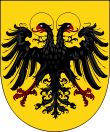 | |
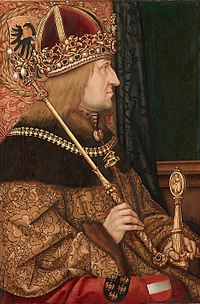 | |
| Details | |
| First monarch | Charlemagne(AD 800 formation) Otto the Great(AD 962 formation) |
| Last monarch | Francis II |
| Formation | 25 December 800 |
| Abolition | 6 August 1806 |
TheHoly Roman Emperor,originally and officially theEmperor of the Romans(Latin:ImperatorRomanorum;German:Kaiserder Römer) during the Middle Ages, and also known as theRoman-German Emperorsince theearly modern period[1](Latin:Imperator Germanorum;German:Römisch-deutscher Kaiser,lit. 'Roman-German emperor'), was the ruler andhead of stateof theHoly Roman Empire.The title was held in conjunction with the title ofking of Italy(Rex Italiae) from the 8th to the 16th century, and, almost without interruption, with the title ofking of Germany(Rex Teutonicorum,lit. 'King of theTeutons') throughout the 12th to 18th centuries.[2]
The Holy Roman Emperor title provided the highest prestige among medieval Catholic monarchs, because the empire was considered by theCatholic Churchto bethe only successorof theRoman Empireduring theMiddle Agesand theearly modern period.Thus, in theory and diplomacy, the emperors were consideredprimus inter pares,regarded as first among equals among other Catholic monarchs across Europe.[3]
From anautocracyinCarolingiantimes (AD 800–924), the title by the 13th century evolved into anelective monarchy,with the emperor chosen by theprince-electors. Various royal houses of Europe, at different times, becamede factohereditary holders of the title, notably theOttonians(962–1024) and theSalians(1027–1125). Following the late medievalcrisis of government,theHabsburgskept possession of the title with onlyone interruptionfrom 1740 to 1745. The final emperors were from theHouse of Habsburg-Lorraine,from 1765 to 1806. The Holy Roman Empire was dissolved byFrancis II,after a devastating defeat byNapoleonat theBattle of Austerlitz.
The emperor was widely perceived to rule bydivine right,though he often contradicted or rivaled thepope,most notably during theInvestiture controversy.The Holy Roman Empire never had anempress regnant,though women such asTheophanuandMaria Theresaexerted strong influence. Throughout its history, the position was viewed as a defender of the Catholic faith. UntilMaximilian Iin 1508, the Emperor-elect (Imperator electus) was required to be crowned by the pope before assuming the imperial title.Charles Vwas the last to be crowned by the pope in 1530. Even after theReformation,the elected emperor was always aCatholic.There were short periods in history when the electoral college was dominated byProtestants,and the electors usually voted in their own political interest.
Title
[edit]

From the time ofConstantine I(r. 306–337), theRoman emperorshad, with very few exceptions, taken on a role as promoters and defenders ofChristianity.Thereign of Constantineestablished a precedent for the position of the Christian emperor in the Church. Emperors considered themselves responsible to God for the spiritual health of their subjects, and after Constantine they had a duty to help the Church define and maintain orthodoxy. The emperor's role was to enforce doctrine, root outheresy,and uphold ecclesiastical unity.[4]Both the title and connection between Emperor andChurchcontinued in theEastern Roman Empirethroughout the medieval period (in exileduring 1204–1261). Theecumenical councilsof the 5th to 8th centuries were convoked by theEastern Roman Emperors.[5]
InWestern Europe,the title ofEmperor in the Westlapsed after the death ofJulius Neposin 480, although the rulers of thebarbarian kingdomscontinued to recognize the authority of the Eastern Emperor at least nominally well into the 6th century. While the reconquest ofJustinian Ihad reestablished Byzantine presence in Italy, religious frictions existed with the Papacy who sought dominance over the Constantinople Church. Toward the end of the 8th century the Papacy still recognised the ruler at Constantinople as the Roman Emperor, though Byzantine military support in Italy had increasingly waned, leading to the Papacy to look to the Franks for protection. In 800Pope Leo IIIowed a great debt toCharlemagne,the King of the Franks and King of Italy, for securing his life and position. By this time, the Eastern EmperorConstantine VIhad been deposed in 797 and replaced as monarch by his mother,Irene.[6]
Under the pretext that a woman could not rule the empire, Pope Leo III declared the throne vacant and crowned Charlemagne Emperor of the Romans (Imperator Romanorum), the successor of Constantine VI as Roman emperor, using the concept oftranslatio imperii.[6]On his coins, the name and title used by Charlemagne isKarolus Imperator Augustus.In documents, he usedImperator Augustus Romanum gubernans Imperium( "Emperor Augustus, governing the Roman Empire" ) andserenissimus Augustus a Deo coronatus, magnus pacificus Imperator Romanorum gubernans Imperium( "most serene Augustus crowned by God, great peaceful emperor governing the empire of the Romans" ). The Eastern Empire eventually relented to recognizing Charlemagne and his successors as emperors, but as "Frankish" and "German emperors", at no point referring to them as Roman, a label they reserved for themselves.[7]
The title of emperor in the West implied recognition by the pope. As the power of the papacy grew during the Middle Ages, popes and emperors came into conflict over church administration. The best-known and most bitter conflict was that known as theinvestiture controversy,fought during the 11th century betweenHenry IVandPope Gregory VII.
After the coronation of Charlemagne, his successors maintained the title until the death ofBerengar I of Italyin 924. The comparatively brief interregnum between 924 and the coronation ofOtto the Greatin 962 is taken as marking the transition from theFrankish Empireto theHoly Roman Empire. Under theOttonians,much of the formerCarolingiankingdom ofEastern Franciafell within the boundaries of the Holy Roman Empire.
Since 911, the variousGerman princeshad elected theKing of the Germansfrom among their peers. The King of the Germans would then be crowned as emperor following the precedent set by Charlemagne, during the period of 962–1530.Charles Vwas the last emperor to be crowned by the pope, and his successor,Ferdinand I,merely adopted the title of "Emperor elect" in 1558. The final Holy Roman emperor-elect,Francis II,abdicated in 1806 during theNapoleonic Warsthat saw the Empire's final dissolution.
The termsacrum(i.e., "holy" ) in connection with the German Roman Empire was first used in 1157 underFrederick I Barbarossa.[8]
The Holy Roman Emperor's standard designation was "August Emperor of the Romans" (Romanorum Imperator Augustus). When Charlemagne was crowned in 800, he was styled as "most serene Augustus, crowned by God, great and pacific emperor, governing the Roman Empire," thus constituting the elements of "Holy" and "Roman" in the imperial title.[9]
The wordRomanwas a reflection of the principle oftranslatio imperii(or in this caserestauratio imperii) that regarded the (Germanic) Holy Roman emperors as the inheritors of the title of emperor of theWestern Roman Empire,despite the continued existence of the Eastern Roman Empire.
In German-language historiography, the termRömisch-deutscher Kaiser( "Roman-German emperor" ) is used to distinguish the title from that ofRoman emperoron one hand, and that ofGerman emperor(Deutscher Kaiser) on the other. The English term "Holy Roman Emperor" is a modern shorthand for "emperor of the Holy Roman Empire" not corresponding to the historical style or title, i.e., the adjective "holy" is not intended as modifying "emperor"; the English term "Holy Roman Emperor" gained currency in the interbellum period (the 1920s to 1930s); formerly the title had also been rendered as "German-Roman emperor" in English.[1]
Succession
[edit]
Theelective monarchyof theKingdom of Germanygoes back to the early 10th century, the election ofConrad I of Germanyin 911 following the death without issue ofLouis the Child,the lastCarolingianruler of Germany.Electionsmeant the kingship of Germany was only partially hereditary, unlike the kingship ofEngland,although sovereignty frequently remained in a dynasty until there were no more male successors. The process of an election meant that the prime candidate had to make concessions, by which the voters were kept on his side, which was known asWahlkapitulationen(electoral capitulation).
Conrad was elected by theGerman dukes,and it is not known precisely when the system of sevenprince-electorswas established. The papal decreeVenerabilembyInnocent III(1202), addressed toBerthold V, Duke of Zähringen,establishes the election procedure by (unnamed) princes of the realm, reserving for the pope the right to approve of the candidates. A letter ofPope Urban IV(1263), in the context of the disputed vote of 1256 and the subsequentinterregnum,suggests that by "immemorial custom",seven princes had the right to elect the king and future emperor. The seven prince-electors are named in theGolden Bull of 1356:thearchbishop of Mainz,thearchbishop of Trier,thearchbishop of Cologne,theking of Bohemia,thecount palatine of the Rhine,theduke of Saxonyand themargrave of Brandenburg.
After 1438, the title remained in the House ofHabsburgandHabsburg-Lorraine,with the brief exception ofCharles VII,who was aWittelsbach.Maximilian I(emperor 1508–1519) and his successors no longer traveled to Rome to be crowned as emperor by the pope. Maximilian, therefore, named himself elected Roman emperor (Erwählter Römischer Kaiser) in 1508 with papal approval. This title was in use by all his uncrowned successors. Of his successors, onlyCharles V,the immediate one, received apapal coronation.
The elector palatine's seat was conferred on theduke of Bavariain 1621, but in 1648, in the wake of theThirty Years' War,the elector palatine was restored, as the eighth elector. TheElectorate of Hanoverwas added as a ninth elector in 1692, confirmed by the Imperial Diet in 1708. The whole college was reshuffled in theGerman mediatizationof 1803 with a total of ten electors, a mere three years before the dissolution of the Empire.
List of emperors
[edit]This list includes all 47 German monarchs crowned from Charlemagne until the dissolution of the Holy Roman Empire (800–1806).
Several rulers were crownedking of the Romans(king of Germany) but not emperor, although they styled themselves thus, among whom were:Conrad IandHenry the Fowlerin the 10th century, andConrad IV,Rudolf I,AdolfandAlbert Iduring theinterregnumof the late 13th century.
Traditional historiography assumes a continuity between theCarolingian Empireand the Holy Roman Empire, while a modern convention takes the coronation of Otto I in 962 as the starting point of the Holy Roman Empire (although the termSacrum Imperium Romanumwas not in use before the 13th century).
Frankish emperors
[edit]On Christmas Day, 800, Charlemagne, King of the Franks, was crowned Emperor of the Romans (Imperator Romanorum) byPope Leo III,in opposition toEmpress Irene,who was then ruling the Roman Empire from Constantinople. Charlemagne's descendants from theCarolingian Dynastycontinued to be crowned Emperor until 899, excepting a brief period when the Imperial crown was awarded to theWidonidDukes of Spoleto.There is some contention as to whether the Holy Roman Empire dates as far back as Charlemagne, some histories consider theCarolingian Empireto be a distinct polity from the later Holy Roman Empire as established under Otto I in 962.
800–888: Carolingian dynasty
[edit]| Portrait | Name Lifespan |
Reign | Relationship with predecessor(s) | Other title(s) | |
|---|---|---|---|---|---|
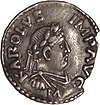
|
Charlemagne(Charles I) 748–814 |
25 December 800 | 28 January 814 | None | |

|
Louis I,the Pious 778–840 |
11 September 813[10] | 20 June 840 | Son ofCharles I | |

|
Lothair I 795–855 |
5 April 823 | 29 September 855 | Son ofLouis I | |

|
Louis II 825–875 |
29 September 855 | 12 August 875 | Son ofLothair I | |

|
Charles II,the Bald 823–877 |
29 December 875 | 6 October 877 | Son ofLouis Iyounger half-brother ofLothair I | |

|
Charles III,the Fat 839–888 |
12 February 881 | 13 January 888 | Grandson ofLouis I | |
891–898: Widonid dynasty
[edit]| Portrait | Name Lifespan |
Reign | Relationship with predecessor(s) | Other title(s) | |
|---|---|---|---|---|---|

|
Guy ?–894 |
21 February 891 | 12 December 894 | 2nd Great-grandson ofCharles I | |
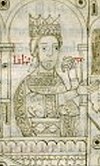
|
Lambert 880–898 |
30 April 892 | 15 October 898 | Son ofGuy | |
896–899: Carolingian dynasty
[edit]| Portrait | Name Lifespan |
Reign | Relationship with predecessor(s) | Other title(s) | |
|---|---|---|---|---|---|
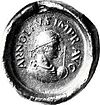
|
Arnulf 850–899 |
22 February 896 | 8 December 899 | Nephew ofCharles III Great-grandson ofLouis I |
|
901–905: Bosonid dynasty
[edit]| Portrait | Name Lifespan |
Reign | Relationship with predecessor(s) | Other title(s) | |
|---|---|---|---|---|---|
| Louis III,the Blind 880–928 |
22 February 901 | 21 July 905 | Grandson ofLouis II | ||
915–924: Unruoching dynasty
[edit]| Portrait | Name Lifespan |
Reign | Relationship with predecessor(s) | Other title(s) | |
|---|---|---|---|---|---|

|
Berengar 845–924 |
December 915 | 7 April 924 | Grandson ofLouis I | |
Holy Roman Emperors
[edit]While earlier Frankish and Italian monarchs had been crowned as Roman emperors, the actualHoly Roman Empireis often considered to have begun with the crowning ofOtto I,at the timeDuke of SaxonyandKing of Germany.Because the King of Germany was an elected position, being elected King of Germany was functionally a pre-requisite to being crowned Holy Roman Emperor. By the 13th century, thePrince-electorsbecame formalized as a specific body of seven electors, consisting of three bishops and four secular princes. Through the middle 15th century, the electors chose freely from among a number of dynasties. A period of dispute during the second half of the 13th century over the kingship of Germany led to there being no emperor crowned for several decades, though this ended in 1312 with the coronation ofHenry VII, Holy Roman Emperor.The period of free election ended with the ascension of the AustrianHouse of Habsburg,as an unbroken line of Habsburgs held the imperial throne until the 18th century. Later a cadet branch known as theHouse of Habsburg-Lorrainepassed it from father to son until the abolition of the Empire in 1806. Notably, from the 16th century, the Habsburgs dispensed with the requirement that emperors be crowned by the pope before exercising their office. Starting withFerdinand I,all successive emperors forwent the traditional coronation.
962–1024: Ottonian dynasty
[edit]| Portrait | Name Lifespan |
Term as King began | Term as Emperor began | Term(s) ended | Relationship with predecessor(s) | Other title(s) |
|---|---|---|---|---|---|---|

|
Otto I,the Great 912–973 |
7 August 936 | 2 February 962 | 7 May 973 | None | |

|
Otto II,the Red 955–983 |
26 May 961 | 25 December 967 | 7 December 983 | Son ofOtto I | |

|
Otto III 980–1002 |
25 December 983 | 21 May 996 | 23 January 1002 | Son ofOtto II | |

|
Henry II[note 1] 973–1024 |
7 June 1002 | 14 February 1014 | 13 July 1024 | Second cousin ofOtto III |
1027–1125: Salian dynasty
[edit]| Portrait | Name Lifespan |
Term as King began | Term as Emperor began | Term(s) ended | Relationship with predecessor(s) | Other title(s) |
|---|---|---|---|---|---|---|
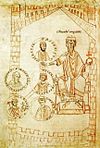
|
Conrad II,the Elder[note 2] 990–1039 |
8 September 1024 | 26 March 1027 | 4 June 1039 | 2nd Great-grandson ofOtto IandEadgyth of EnglandthroughLiutgarde, Duchess of Lorraine | |
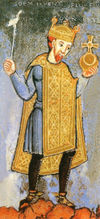
|
Henry III,the Black 1017–1056 |
14 April 1028 | 25 December 1046 | 5 October 1056 | Son ofConrad II | |
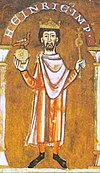
|
Henry IV 1050–1106 |
17 July 1054 | 1 April 1084 | 7 August 1106 | Son ofHenry III | |

|
Henry V[11] 1086–1125 |
6 January 1099 | 13 April 1111 | 23 May 1125 | Son ofHenry IV |
1133–1137: Supplinburg dynasty
[edit]| Portrait | Name Lifespan |
Term as King began | Term as Emperor began | Term(s) ended | Relationship with predecessor(s) | Other title(s) |
|---|---|---|---|---|---|---|

|
Lothair II[note 3] 1075–1137 |
30 August 1125 | 4 June 1133 | 4 December 1137 | 6th Great-grandnephew ofOtto I |
1155–1197: Staufen dynasty
[edit]| Portrait | Name Lifespan |
Term as King began | Term as Emperor began | Term(s) ended | Relationship with predecessor(s) | Other title(s) |
|---|---|---|---|---|---|---|
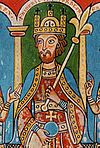
|
Frederick IBarbarossa 1122–1190 |
4 March 1152 | 18 June 1155 | 10 June 1190 | Great-grandson ofHenry IVthroughAgnes of Waiblingen Descendant ofOtto IIthroughMatilda of Germany |
|
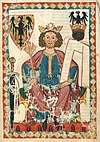
|
Henry VI 1165–1197 |
15 August 1169 | 14 April 1191 | 28 September 1197 | Son ofFrederick I |
1198–1215: Welf dynasty
[edit]| Portrait | Coat of arms | Name Lifespan |
Term as King began | Term as Emperor began | Term(s) ended | Relationship with predecessor(s) | Other title(s) |
|---|---|---|---|---|---|---|---|
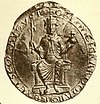
|

|
Otto IV 1175–1218 |
9 June 1198 | 21 October 1209 | 1215 | Great-grandson ofLothair IIthroughGertrude of Süpplingenburg |
1220–1250: Staufen dynasty
[edit]| Portrait | Name Lifespan |
Term as King began | Term as Emperor began | Term(s) ended | Relationship with predecessor(s) | Other title(s) |
|---|---|---|---|---|---|---|

|
Frederick II, Stupor Mundi1194–1250 |
5 December 1212 | 22 November 1220 | 13 December 1250 | Son ofHenry VI |
Theinterregnumof the Holy Roman Empire is taken to have lasted from the deposition of Frederick II byPope Innocent IVin 1245 (or alternatively from Frederick's death in 1250 or from the death ofConrad IVin 1254) to the election ofRudolf I of Germany(1273). Rudolf was not crowned emperor, nor were his successorsAdolfandAlbert.The next emperor wasHenry VII,crowned on 29 June 1312 byPope Clement V.
1312–1313: House of Luxembourg
[edit]| Portrait | Coat of arms | Name Lifespan |
Term as King began | Term as Emperor began | Term(s) ended | Relationship with predecessor(s) | Other title(s) | |||
|---|---|---|---|---|---|---|---|---|---|---|
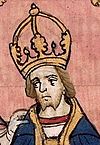
|
|
Henry VII 1273–1313 |
27 November 1308 | 29 June 1312 | 24 August 1313 | Descendant ofCharles II |
1314–1347: House of Wittelsbach
[edit]| Portrait | Coat of arms | Name Lifespan |
Term as King began | Term as Emperor began | Term(s) ended | Relationship with predecessor(s) | Other title(s) | |||
|---|---|---|---|---|---|---|---|---|---|---|

|
|
Louis IV,the Bavarian 1282–1347 |
20 October 1314 | 17 January 1328 | 11 October 1347 | Descendant ofOtto II(throughMatilda of Germany), Henry IV(throughAgnes of Waiblingen andLothair II(throughGertrude of Süpplingenburg) |
1346–1437: House of Luxembourg
[edit]| Portrait | Coat of arms | Name Lifespan |
Term as King began | Term as Emperor began | Term(s) ended | Relationship with predecessor(s) | Other title(s) | |||
|---|---|---|---|---|---|---|---|---|---|---|
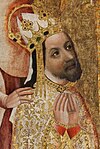
|
|
Charles IV 1316–1378 |
11 July 1346 | 5 April 1355 | 29 November 1378 | Grandson ofHenry VII Descendant ofFrederick IthroughPhilip of Swabia |
||||

|
|
Sigismund 1368–1437 |
10 September 1410 /21 July 1411 |
31 May 1433 | 9 December 1437 | Son ofCharles IV |
1440–1740: House of Habsburg
[edit]In 1508,Pope Julius IIallowedMaximilian Ito use the title of Emperor without coronation in Rome, though the title was qualified asElectus Romanorum Imperator( "elected Emperor of the Romans" ). Maximilian's successors each adopted the same titulature, usually on becoming the sole ruler of the Holy Roman Empire. Maximilian's predecessorFrederick IIIwas the last to be crowned Emperor by the Pope in Rome, while Maximilian's successorCharles Vwas the last to be crowned by the pope, though inBologna,in 1530.[12]
| Portrait | Coat of arms | Name Lifespan |
Term as King began | Term as Emperor began | Term(s) ended | Relationship with predecessor(s) | Other title(s) |
|---|---|---|---|---|---|---|---|
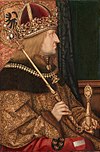
|
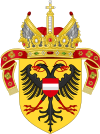
|
Frederick III,the Peaceful 1415–1493 |
2 February 1440 | 16 March 1452 | 19 August 1493 | Second cousin ofAlbert II of Germany,Emperor designate Descendant ofFrederick I(throughOtto I, Count of Burgundy) Descendant ofLothair II(throughGertrude of Süpplingenburg) |
|
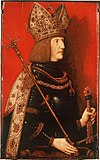
|

|
Maximilian I 1459–1519 |
16 February 1486 | 4 February 1508 | 12 January 1519 | Son ofFrederick III Descendant ofFrederick IIthroughManfred, King of Sicily |
|

|
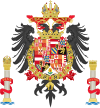
|
Charles V 1500–1558 |
28 June 1519 | 27 August 1556 | Grandson ofMaximilian I | ||
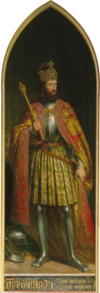
|

|
Ferdinand I 1503–1564 |
5 January 1531 | 27 August 1556 | 25 July 1564 | Brother ofCharles V Grandson ofMaximilian I |
|

|
Maximilian II 1527–1576 |
22 November 1562 | 25 July 1564 | 12 October 1576 | Son ofFerdinand I Descendant ofSigismundthroughElizabeth of Luxembourg | ||

|

|
Rudolf II[note 4] 1552–1612 |
27 October 1575 | 12 October 1576 | 20 January 1612 | Son ofMaximilian II Grandson ofCharles V | |

|
Matthias 1557–1619 |
13 June 1612 | 20 March 1619 | Brother ofRudolf II Son ofMaximilian II Grandson ofCharles V | |||

|
Ferdinand II 1578–1637 |
28 August 1619 | 15 February 1637 | Cousin ofRudolf IIandMatthias Grandson ofFerdinand I | |||

|

|
Ferdinand III 1608–1657 |
22 December 1636 | 15 February 1637 | 2 April 1657 | Son ofFerdinand II | |

|

|
Leopold I 1640–1705 |
18 July 1658 | 5 May 1705 | Son ofFerdinand III Great-great-grandson ofCharles VandMaximilian II | ||

|

|
Joseph I 1678–1711 |
23 January 1690 | 5 May 1705 | 17 April 1711 | Son ofLeopold I | |

|
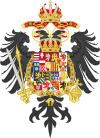
|
Charles VI 1685–1740 |
12 October 1711 | 20 October 1740 | Brother ofJoseph I Son ofLeopold I |
||
1742–1745: House of Wittelsbach
[edit]| Portrait | Coat of arms | Name Lifespan |
Term as King began | Term as Emperor began | Term(s) ended | Relationship with predecessor(s) | Other title(s) |
|---|---|---|---|---|---|---|---|

|
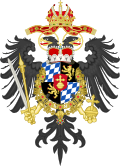
|
Charles VII 1697–1745 |
24 January 1742 | 20 January 1745 | Great-great-grandson ofFerdinand II Son-in-law ofJoseph I |
||
1745–1765: House of Lorraine
[edit]| Portrait | Coat of arms | Name Lifespan |
Term as King began | Term as Emperor began | Term(s) ended | Relationship with predecessor(s) | Other title(s) |
|---|---|---|---|---|---|---|---|

|

|
Francis I 1708–1765 |
13 September 1745 | 18 August 1765 | Great-grandson ofFerdinand III Son-in-law ofCharles VI |
||
1765–1806: House of Habsburg-Lorraine
[edit]| Portrait | Coat of arms | Name Lifespan |
Term as King began | Term as Emperor began | Term(s) ended | Relationship with predecessor(s) | Other title(s) |
|---|---|---|---|---|---|---|---|

|

|
Joseph II 1741–1790 |
27 March 1764 | 18 August 1765 | 20 February 1790 | Son ofFrancis I and EmpressMaria Theresa of Austria,de factoruler of the empire Grandson ofCharles VI |
|

|
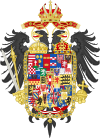
|
Leopold II 1747–1792 |
30 September 1790 | 1 March 1792 | Brother ofJoseph II | ||

|
Francis II 1768–1835 |
5 July 1792 | 6 August 1806 | Son ofLeopold II | |||
Coronation
[edit]The Emperor was crowned in a special ceremony, traditionally performed by thePopeinRome.Without that coronation, no king, despite exercising all powers, could call himself Emperor. In 1508, PopeJulius IIallowedMaximilian Ito use the title of Emperor without coronation in Rome, though the title was qualified asElectus Romanorum Imperator( "elected Emperor of the Romans" ). Maximilian's successors adopted the same titulature, usually when they became the sole ruler of the Holy Roman Empire.[13]Maximilian's first successorCharles Vwas the last to be crowned Emperor.
| Emperor | Coronation date | Officiant | Location |
|---|---|---|---|
| Charles I | 25 December 800 | Pope Leo III | Rome,Italy |
| Louis I | 5 October 816 | Pope Stephen IV | Reims,France |
| Lothair I | 5 April 823 | Pope Paschal I | Rome, Italy |
| Louis II | 15 June 844 | Pope Leo IV | Rome, Italy |
| Charles II | 29 December 875 | Pope John VIII | Rome, Italy |
| Charles III | 12 February 881 | Rome, Italy | |
| Guy III of Spoleto | 21 February 891 | Pope Stephen V | Rome, Italy |
| Lambert II of Spoleto | 30 April 892 | Pope Formosus | Ravenna,Italy |
| Arnulf of Carinthia | 22 February 896 | Rome, Italy | |
| Louis III | 15 or 22 February 901 | Pope Benedict IV | Rome, Italy |
| Berengar | December 915 | Pope John X | Rome, Italy |
| Otto I | 2 February 962 | Pope John XII | Rome, Italy |
| Otto II | 25 December 967 | Pope John XIII | Rome, Italy |
| Otto III | 21 May 996 | Pope Gregory V | Monza,Italy |
| Henry II | 14 February 1014 | Pope Benedict VIII | Rome, Italy |
| Conrad II | 26 March 1027 | Pope John XIX | Rome, Italy |
| Henry III | 25 December 1046 | Pope Clement II | Rome, Italy |
| Henry IV | 31 March 1084 | Antipope Clement III | Rome, Italy |
| Henry V | 13 April 1111 | Pope Paschal II | Rome, Italy |
| Lothair III | 4 June 1133 | Pope Innocent II | Rome, Italy |
| Frederick I | 18 June 1155 | Pope Adrian IV | Rome, Italy |
| Henry VI | 14 April 1191 | Pope Celestine III | Rome, Italy |
| Otto IV | 4 October 1209 | Pope Innocent III | Rome, Italy |
| Frederick II | 22 November 1220 | Pope Honorius III | Rome, Italy |
| Henry VII | 29 June 1312 | Ghibellinescardinals | Rome, Italy |
| Louis IV | 17 January 1328 | SenatorSciarra Colonna | Rome, Italy |
| Charles IV | 5 April 1355 | Pope Innocent VI's cardinal | Rome, Italy |
| Sigismund | 31 May 1433 | Pope Eugenius IV | Rome, Italy |
| Frederick III | 19 March 1452 | Pope Nicholas V | Rome, Italy |
| Charles V | 24 February 1530 | Pope Clement VII | Bologna,Italy |
See also
[edit]- Concordat of Worms
- Emperorfor other uses of the title "Emperor" inEurope
- First Council of the Lateran
- Holy Roman Emperors family tree
- Holy Roman Empress
- King of the Romans
- List of German monarchs
- Holy Roman Empire
- King of Italy
- Kingdom of Italy (Holy Roman Empire)
Notes
[edit]- ^Enumerated as successor of Henry I who was German King 919–936 but not Emperor.
- ^Enumerated as successor of Conrad I who was German King 911–918 but not Emperor
- ^Enumerated also Lothair III as successor of Lothair II, who was King of Lotharingia 855–869 but not Emperor
- ^Enumerated as successor ofRudolph Iwho was German King 1273–1291.
References
[edit]- ^abThe New International Encyclopædia.Vol. 10. 1927. p. 675.;Hayes, Carlton J. H.(1932).A Political and Cvltvral History of Modern Europe.Vol. 1. p. 225.
- ^Peter Hamish Wilson,The Holy Roman Empire, 1495–1806,MacMillan Press 1999, London, p. 2. Erik von Kuehnelt-Leddihn: The Menace of the Herd or Procrustes at Large – p. 164. Robert Edwin Herzstein, Robert Edwin Herzstein: "The Holy Roman Empire in the Middle Ages: universal state or German catastrophe?"[year needed][page needed]
- ^Terry Breverton(2014).Everything You Ever Wanted to Know About the Tudors but Were Afraid to Ask.Amberley Publishing.p. 104.ISBN9781445638454.
- ^Richards, Jeffrey (1979).The Popes and the Papacy in the Early Middle Ages, 476–752.London: Routledge & Kegan Paul. pp. 14–15.
- ^Richards 1979,p. 16.
- ^abBryce, James(1968) [1864].The Holy Roman Empire.Macmillan. pp. 62–64.
- ^Klewitz, Hans-Walter (1943). "Eduard Eichmann, die Kaiserkrönung im Abendland. Ein Beitrag zur, Geistesgeschichte des Mittelalters, mit besonderer Berücksichtigung des kirchlichen Rechts, der Liturgie und der Kirchenpolitik".Zeitschrift der Savigny-Stiftung für Rechtsgeschichte: Kanonistische Abteilung.32:509–525.doi:10.7767/zrgka.1943.32.1.509.S2CID183386465.
- ^Moraw, Peter (1977–1999).Heiliges Reich.Lexikon des Mittelalters.Vol. 4. Munich & Zurich: Artemis. Columns 2025–2028.
- ^Bryce 1968,p. 530.
- ^Egon Boshof:Ludwig der Fromme.Darmstadt 1996, p. 89
- ^Barraclough, Geoffrey (1984).The Origins of Modern Germany.W. W. Norton & Company.ISBN978-0-393-30153-3.
- ^Brinckmeier, Eduard (1882).Praktisches Handbuch der historischen Chronologie aller Zeiten und Völker, besonders des Mittelalters.p. 311.
- ^"Wir Franz der Zweyte, von Gottes Gnaden erwählter römischer KaiserImperator Austriae, Fransiscus I (1804),Allerhöchste Pragmatikal-Verordnung vom 11. August 1804,The HR Emperor, p. 1
External links
[edit] Media related toHoly Roman Emperorsat Wikimedia Commons
Media related toHoly Roman Emperorsat Wikimedia Commons







